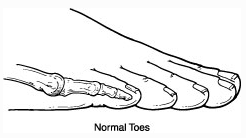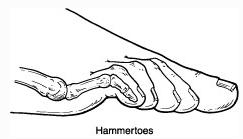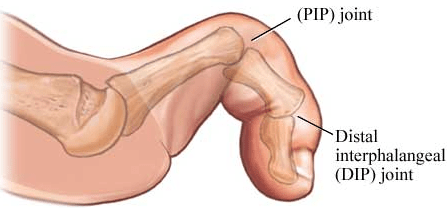Hammertoes
Hammertoes is when one or both of the joints in the little toes bend and deform in the shape of an upside down parabola. This deformation is progressive and worsens with time to become an issue. Specifically, hammertoes can be painful as the joints press up against the footwear and can also lead to other issues. To avoid surgery, hammertoes are best treated as early as possible due to the fact that non-invasive solutions, such as orthotics, are only effective up until a certain stage. This stage is when the toes become rigid, at which point surgery will become necessary.


Causes
Hammertoes can be the result of multiple factors. Some of them may include:
- Improper fitting footwear with tight toe boxes
- Toe injuries that knock the joint out of place
- Bone/joint disorder such as arthritis
- Inherited from birth
- Tightened ligaments and tendons (imagine a suspended bridge with one row of cables much tighter than the other)
Patients who wear footwear with tight toe boxes (toes are forced to curl inwards) greatly increase the risk of developing hammertoes. Additional risk factors which contribute to the development of hammer toes include having a family history with this disorder and having calluses or bunions.

Symptoms
Symptoms are indicators of a problem and for hammertoes, some of them may include:
- A toe that bends downwards
- Toes that feel rigid
- Development of corns and calluses on or between the toes
- A toe that is shaped like a claw
- Toes that hurt with physical activity
- Toes that hurt when wearing shoes
- Open sores (severe cases)
Hammertoes may worsen over a period of time and will not go away on it’s own. It may lead to pain and after a certain point, non-invasive techniques such as orthotics are ineffective and surgery will become the best option.
Treatment
Hammertoes may not need surgery as long as the issue is identified and non-invasive treatment is pursued early. Orthotics and the proper footwear are such examples of effective, non-invasive solutions that will treat the foot for the long-term.
- Custom orthotics work by supporting the body’s frame through the foot. This is done by realigning the ankle and lower legs in order to correct the motion of the foot. In the case of hammertoes, Rite Gait’s handcrafted custom orthotics will be designed to cushion the toes and support them in a comfortable position. They will shift the position of the toe to correct the problem and help you become pain-free.
- The proper footwear is important in the treatment of hammertoes. Specifically, the footwear must have a wide and long-enough toe box which will not compress the toes in any direction. The footwear must also provide enough room so as to ensure they do not aggravate or aid in the creation of callouses or corns, which can become painful.
At Rite Gait, our pedorthists will handcraft your custom orthotics and help you find the perfect footwear in order to treat hammertoes. Additionally, if we don’t already carry the perfect footwear to suit your needs, we can make modifications using the onsite lab.
MILTON LOCATION
- 335 Main St E, Milton, ON L9T 1P5
- (905) 876-1095
- ritegait@gmail.com
- WEEKDAYS: 10 AM - 6 PM
SATURDAYS: 9:30 AM - 2:30 PM
SUNDAYS: Closed